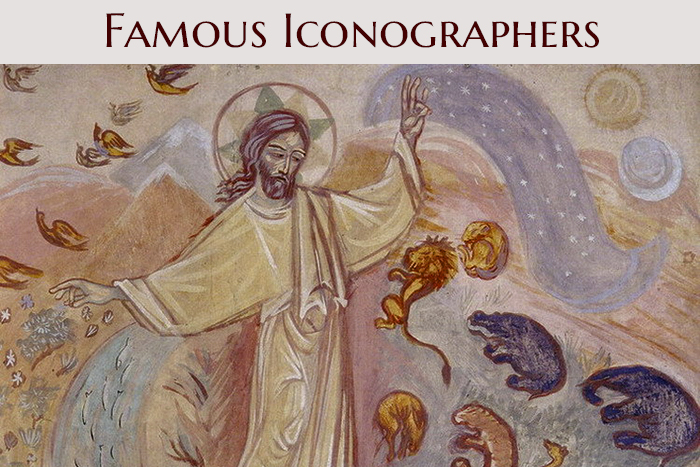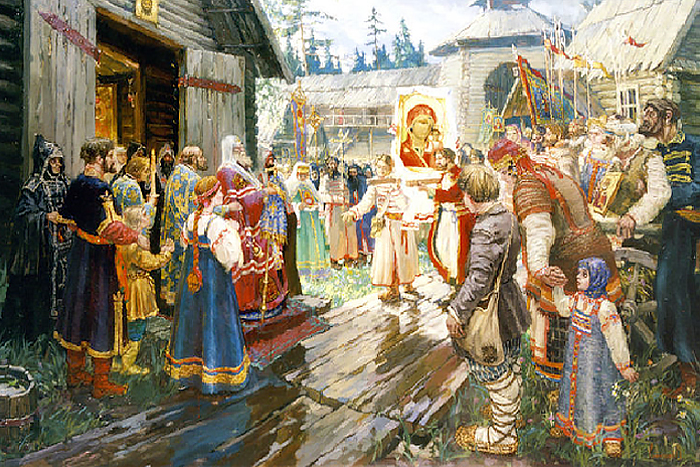
There are a number of icons depicting Sophia, the Wisdom of God, in the Russian Orthodox Church, namely, in Kiev, Novgorod, Vologda, Tobolsk, Moscow, Holy Trinity Saint Sergius Lavra, and other places. They depict the Mother of God and the hypostatic Wisdom – the Son of God – who was incarnated through her. All these icons convey one main idea. They take the Wisdom, or Sophia, to represent the Son of God, based on Proverbs 9, where it is said, Wisdom hath builded her house, she hath hewn out her seven pillars. These words point at Christ, the Son of God, who is called God’s Power and God’s Wisdom in the Epistles; the word house alludes to the most holy Virgin Mary who contributed to the incarnation of the Son of God. These are the words that the iconography of Saint Sophia, the Wisdom of God, is based on.
The icon of Sophia, the Wisdom of God, located in the Sophia Cathedral in Kiev, is the most ancient of such icons. That icon was borrowed from Justinian’s Church in Constantinople. It exemplifies the union between the triumphant and the militant Church through the incarnation of the Son of God who is the Wisdom of God. There is a house or a temple on that icon, with a standing figure of the Mother of God wearing a tunic and a veil, under a canopy supported with seven pillars. Her arms and hands are spread out, while her feet stand on the crescent. The Everlasting Baby rests on his Mother’s bosom. He blesses the faithful with his right hand and holds the orb in his left hand. There is a quotation from the Book of Proverbs on the cornice of the canopy, Wisdom hath builded her house, she hath hewn out her seven pillars. There is the Holy Spirit surrounded by rays of light depicted right above the canopy. God the Father, covered with light, with the orb in his left hand and his right hand making the blessing sign, is portrayed at the top with words that appear as if coming out of his mouth, “I have established Her feet.” There are seven Archangels with outstretched wings on both sides of God the Father and the Holy Spirit, holding in their hands symbols of their duties: Michael with a flaming sword, Uriel with a lightning flash hurling downwards, Raphael with an alabaster vessel of myrrh on the right side; Gabriel with a lily blossom, Selaphiel with a scale, Jerudiel with a royal crown, and Barachiel with flowers on a white shawl on the left side.

There is an ambo with seven footsteps, which represents the Church of God on earth with the Old Testament witnesses of the incarnation of the Wisdom, that is, the Forefathers and Prophets, under the cloud and the crescent that serves as the foothold for the Mother of God. Moses stands on the fourth step from above on the right side, holding stone tablets with the following words inscribed on them, “Hail, O God’s tablet on which the Father’s finger wrote the Word of God”. There are the following figures following Moses in the descending order: Aaron wearing a miter of the high priest and with the blossoming rod in his hand; and David wearing his crown, royal mantle, and the Ark of Covenant. On the left side, opposite from Moses and on the same step, there is Isaiah the Prophet with a scroll hanging down his left shoulder. The scroll reads, “Behold, a virgin shall conceive, and bear a son.” Then there are Jeremiah with a scroll, Ezekiel with locked gates, and Daniel with a rock in his hand. Aside from that, there is a word on each of the seven steps: faith, hope, love, purity, humility, goodness, and glory. The seven steps stand on seven pillars, which have images from the Revelation on them, with explanations. The first pillar has an image of seven eyes and the explanation, which reads, Gift of Advice; the second pillar has a menorah with the inscription, Gift of Reason; the third pillar has a book with seven seals and its explanation reads, Gift of Wisdom. The first left-side pillar has an image of seven trumpets and the explanation, Gift of Power; the second left-side pillar has an image of a right hand with seven stars and the inscription, Gift of Knowledge; the third one has seven smoking censers and the inscription, Gift of Piety; the fourth and the last pillar has seven thunderbolts and the inscription reads, Gift of Fear of God. Thus, apart from the Mother of God and the Holy Trinity, there are seven instances of all objects and subjects on this icons and they all have symbolic meanings. This is the description of the Kiev icon of Sophia, the Wisdom of God.
Not all images of Sophia, the Wisdom of God, are the same. Novgorod icon of Sophia in the eponymous cathedral belongs to the Deesis type (the Greek word deesis means supplication; this is the type of iconography where the Mother of God and St. John the Baptist bow to the Savior). This icon depicts Christ the Pantocrator in a royal attire, with flaming wings on a throne of fire, buttressed by seven pillars. The sky that surrounds the Pantocrator is blue and spotted by stars. There are the Mother of God and St. John the Baptist on both sides, as the closest witnesses of the incarnation of the Word of God. The image of the Savior in a circle of fire with an inscription Wisdom of God on it is shown above.
The Novgorod icon of Sophia is considered to be wonder-working. The surviving historical record tells us that a woman with eye disease was healed by this icon in 1542. All images of Sophia the Wisdom of God express the idea of the Mother of God, who served as a tool for the embodiment of the hypostatic Wisdom, the Son of God. For this reason, the festivity of the icon of Sophia is also celebrated by the Orthodox Church on Marian holidays and mainly on the Nativity of the Virgin Mary (e. g., in Kiev), or on the Dormition of the Blessed Virgin Mary, as in Novgorod, Vologda, Tobolsk, Moscow and other places where there are icons of Sophia, the Wisdom of God.
Translated by The Catalog of Good Deeds



